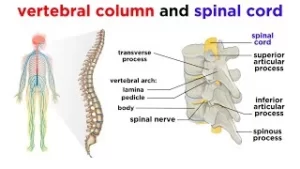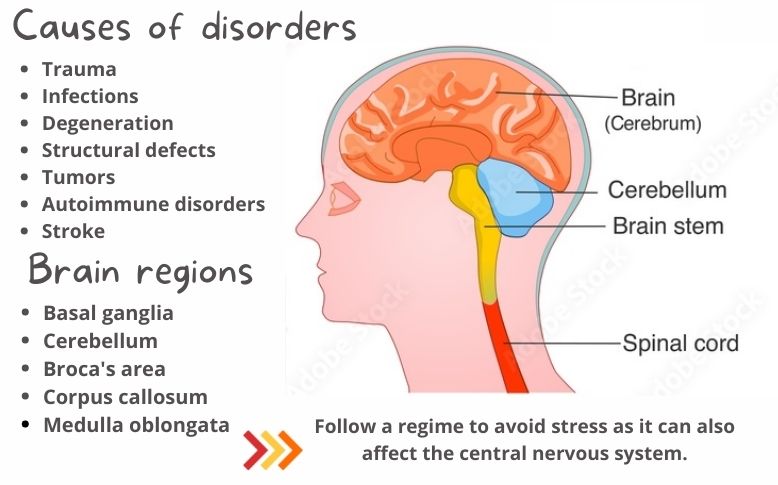What is the Central Nervous System?
The central nervous system (CNS) is a substantial body part that consists of the brain and spinal cord. The skull (cranial cavity) protects the brain, and the spinal cord travels from the back part of the brain down to the center of the spine, stopping in the lumbar region of the lower back.
Meninges: It is a protective triple-layered membrane that houses both the brain and spinal cord. Sometimes we consider the retina, optic nerve, olfactory epithelium, and olfactory nerves to be a part of the CNS together with the brain and spinal cord.
Central Nervous System Function
The central nervous system has been a part of thorough studies for anatomists and physiologists, but it still has kept many secrets; it controls our thoughts, emotions, movements, and desires. The central nervous system controls our heart rate, breathing, body temperature, the release of some hormones, and much more.
Central Nervous System Composition
Here, we will discuss both primary parts of the central nervous system: the brain and the Spinal cord. The brain As we all know, it is the most complex organ of the human body; the cerebral cortex (the most considerable part by volume and the outermost part of the brain) contains around 15 to 33 million neurons, and each of the neurons are connected to thousands of other neurons. Approximately 100 billion neurons and a thousand billion glial (support) cells make up the human brain. Our brain uses about 20% of our body’s total energy.
The brain is the central control system of the body that coordinates activity, from physical motion to the creation of memories, the secretion of hormones, and the sensation of emotion. To carry out various functions, some brain sections have dedicated roles. However, many higher functions such as problem-saving, reasoning, and creativity involve different areas to work together in a fixed network.
The four roughly split lobes of the brain include:
- Temporal lobe (green): is essential for processing sensory input and assigning emotional meaning to it. The temporal lobe is also helpful in laying down long-term memories, and some aspects of language perception also take place here.
- Occipital lobe (purple)- It is the visual processing region of the brain that houses the visual cortex.
- Parietal lobe (purple)– It integrates sensory information regarding touch, navigation, and spatial awareness. Touch stimulation beginning from the skin ultimately reaches the parietal lobe. This lobe also plays a role in language processing.
- Frontal lobe (pink)– It is set at the front of the brain; the frontal lobe contains most dopamine-sensitive neurons and is involved in attention, short-term memory, reward, motivation, and planning.
Brain regions
- Basal ganglia: It helps control voluntary muscle movements, procedure learning, and making decisions regarding which motor activities to carry out. Diseases that may affect this part of the brain include Huntington’s disease and Parkinson’s disease.
- Cerebellum: It mainly deals with precise motor control, but also in attention and language perception. If the cerebellum is damaged, the primary symptom is ataxia, a condition concerning disrupted motor control.
- Broca’s area: A small area on the left part of the brain (sometimes on the right side in left-handed individuals) plays a vital role in language processing. When damaged, a person finds it difficult to understand what is being said. Sometimes, stuttering is linked with underactive Broca’s area.
- Corpus callosum: It is a broad structure of nerve fibers that joins the right and left hemispheres. The Corpus callosum is the largest white matter structure present in the brain that allows the two hemispheres to communicate. Dyslexic children have a smaller corpus callosum size; ambidextrous people, left-handed people, and musicians have a typically larger one.
- Medulla oblongata: extending below the skull, this part is involved in involuntary functions, such as breathing, sneezing, vomiting, and maintaining the appropriate blood pressure.
Hypothalamus is set up just above the brainstem and quite the size of an almond; this part of the brain secretes several neurohormones that impact body temperature control, hunger, and thirst.
- Thalamus: It is positioned in the center part of the brain; the thalamus accepts sensory and motor input that relays it to the rest of the cerebral cortex. It helps regulate sleep, consciousness, alertness, and awareness.
- Amygdala: It is two almond-shaped nuclei stored deep within the temporal lobe. This part is responsible for decision-making, emotional responses, and memory, specifically adverse effects.
Spinal cord

The spinal cord that runs almost the entire back length sinks the information between the brain and body and carries our other specific tasks. From the brainstem, where the brain and spinal cord meets, 31 spinal cords enter the cord. Its length connects with the peripheral nervous system (PNS) nerves that run in from the muscles, skin, and joints. Motor commands from the brain travel directly from the spine to the muscles. In contrast, the sensory information travels from the sensory tissues, including the skin, towards the spinal cord and eventually ends up in the brain
The spinal cord contains various circuits that control specific reflexive responses, including the involuntary movement of your arm made if your finger accidentally touches a flame. The circuits within the spine can also aid more complex movements such as walking. Even without any brain input, the spinal nerves can coordinate the muscles required to walk. For example, if the brain and spine are separated so that the brain has no contact with the body, it will begin spontaneously walking while placing it on the treadmill. The effective functioning of the brain is only to start and stop the process or make changes if an object appears in your path.
Central Nervous System (CNS) Diseases
The major causes of disorders or diseases that affect the CNS may include:
- Trauma: Based upon the injury site, symptoms can range widely from paralysis to mood disorders.
- Infections: Some viruses and microorganisms can invade the core of the central nervous system; these include protozoa; fungi, such as cryptococcal meningitis; viruses; malaria; bacteria, as in the case of leprosy.
- Degeneration: In some rare cases, the brain and spinal cord can regenerate. Parkinson’s disease is one of the examples which involves the gradual disintegration of dopamine-producing cells present in the basal ganglia.
- Structural defects: The most common example includes congenital disabilities, such as anencephaly, where parts of the brain, skull, and scalp are missing at birth.
- Tumors: Both noncancerous and cancerous tumors can affect parts of the central nervous system. Both types of tumors can cause CNS damage and yield an array of symptoms depending upon the part of the body where it develops.
- Autoimmune disorders: In some cases, an individual’s immune system can mount an attack on the healthy cells. For instance, the characteristics of an acute disseminated encephalomyelitis is an immune response against the spinal cord and brain, attacking the nerves’ insulation (myelin) and destroying white matter of the brain.
- Stroke: It is a blood supply interruption to the brain; the resulting oxygen deficiency causes tissue to die in the infected area.
How does alcohol affect the CNS and brain?
Alcohol addiction or overconsumption can affect several brain parts and, in general, contract brain tissues, destroy brain cells, and, most importantly, depress the central nervous system. Excessive drinking over a prolonged period can cause severe problems with cognition and memory. Alcohol is a depressant product that can slow down the significant functions of the CNS and cause mental confusion, slurred speech, poor muscle control, and blurry vision.
How to keep the nervous system healthy?
Just like other body parts, your brain also needs proper sleep for rest and repair, and primarily an excellent regular sleep cycle is the key. A healthy balanced diet that contains food rich in omega-3 fatty acids is also important. It can include fatty fish such as albacore tuna, salmon, herring, mackerel, and farmed trout.
Follow a regime to avoid stress as it can also affect the central nervous system. A few things you can do to keep your CNS healthy may include:
- Allow yourself to take a break
- Exercise regularly
- Try spending time with family and friends
- Practice mindfulness with yoga or meditate

